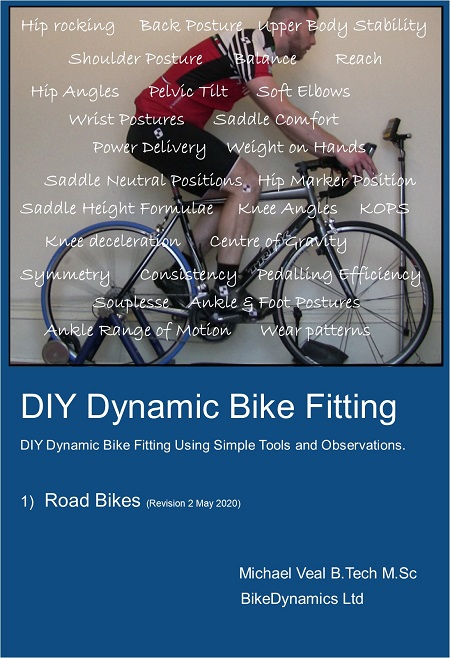Cycling Foot Pain and Numbness

Foot Pain - Outside Edge
One of the most common foot discomforts experienced by BikeDynamics customers is along the outside edge, usually after two or three hours of cycling. Occasionally this is due to poor cleat position holding the feet 'toed in', but the more usual reasons are either a strong fore-foot varus or that the load paths from knees to feet are offset, as shown here. This will be because the hips are spaced wider than the pedal spacing, or hip joint inflexibility will encourage an outboard knee trajectory. The simple solution here is widen the pedal stance, either with a washer between crank and pedal, cranks with a wider Q factor, or pedals with longer spindles. If the cyclist has a strong fore-foot varus, using a wedge or shim can also help spread loads over the whole foot.

Numb Toes
Poor circulation and riding in the cold can cause the toes to go numb, but many people get this all the time. A frequent error is to place the cleats too far forwards, which can contribute to Metatarsalgia or irritation of the nerves between the metatarsal bones. This can also manifest as a 'Hotfoot' a hot, tingling sensation under the balls of the feet. People with high insteps tend to suffer the most from these issues. This is because the reduced contact beneath their high arches increases the pressure directly under the balls of the feet. Insoles with more arch support can help to spread loads more evenly over the whole foot. Many shoe manufacturers mould a domed raised area into their insoles below the metatarsal bones. Often called a Metatarsal 'Button' this is desiged to gently spread the foot bones apart, hopefully reducing the propensity for nerve irritation.

Foot Discomfort - Shoes too Tight
If feeling any foot discomfort, the first thing to check is that the straps, buckles or Boas are not done up too tightly. Our feet will tend to swell as we ride, so what may feel like a snug fit when we first put our shoes on can become too tight later in the day. Compared with velcro or buckles, Boa fastenings can sometime be a bit unyielding. So whereas you may get some 'give' in many shoes, allowing that foot expansion, Boas can remain or become tight.

Ankle Postures
An excessively high or low saddle can cause discomfort in the feet from a number of different mechanisms. A very toe down foot posture will tend to push the foot into the shoe, squashing the bones together as if the straps were too tight. The heel of the shoe may also dig into the Achilles tendon. A very low saddle will require a strongly dorsiflexed foot (toe up) with some customers finding the tongue of their shoe digging into their ankles.
Foot Travel
The foot will move in the shoe, often intentionally, but sometimes not. The natural flattening of the arches as load is applied through the fore foot will tend to lengthen the foot, then shorten it as the load is reduced on the upstroke. As cyclists we try to develop a smooth 'pedalling in circles' pedal stroke. But this means we need to push forwards over the top and scrape back through the bottom of the stroke. If the foot is not adequately restrained, it will tend to rattle back and forth as this cyclical load is applied, often encouraging the cyclist to scrunch their toes up. The depth of the toe box and the height of any arch support have a strong influence on the perception of restraint.
Cleat Position - Very Wide Feet.
The influence of the longitudinal cleat position was mentioned previously with respect to 'Hotfoot' and numb toes. People with very wide feet, often find they are unable to get the cleats back far enough. This is because their choice of shoe size is driven by the width of their feet, not the length. For example, they may need a size 44 to accommodate their foot width, but in reality the length would indicate a 42. The problem here is that the cleat fixing positions on the base of the shoe will be assuming a 44 foot length and in the order of 10mm too far forwards. The fore-aft adjustability of cleats would not be enough to put the cleat in the right location. Countermeasures in these instances include buying shoes known for having wide fittings or using Speedplay pedals that have optional 'Cleat Extender Plates' to move the cleat some distance from the nominal location.
DIY Dynamic Bike Fitting
You may be interested in our downloadable DIY guide.
49 Page PDF download describing all the observations, simple measurements and calculations required to do your own Dynamic Bike Fits.
Revision 2 released May 2020.
Contains updated male and female saddle height calculators and new information on male / female leg length proportions. Plus a new section to assist with saddle choice and improving comfort.
British Pound, Euro and US Dollar payments are processed by PayPal and all major credit cards are accepted. You will receive an email confirming your payment and will be automatically redirected to a page where you can download the ebook. The ebook is in PDF format so you will need to have a copy of Adobe Acrobat Reader or a similar PDF reader to read the ebook.


